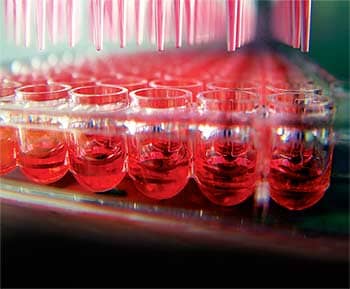
Driven by unique needs and limited by individual resources, today’s clinical laboratories fall across the continuum of automation, from full manual labor to total lab automation.
“Without being melodramatic, laboratories live or die on providing results continuously for their customers,” says Colin Hill, director of clinical lab marketing for systems and automation, Ortho Clinical Diagnostics, part of the Johnson and Johnson family of companies, Raritan, NJ. Faced with the persistent challenges of staffing shortages, tight budgets, and growing volumes, more laboratories seek solutions to this continuous drive to produce in automation.
Unfortunately, simply adding technology cannot solve a laboratory’s problems. It is important that laboratory administrators consider the entire laboratory process before plugging in to automation. “An analyzer on its own will not solve the customer’s problem. It requires a more holistic approach that looks at what the business goals are,” Hill says.
Many laboratories will find they cannot leap in with total automation anyway. Often the major obstacle is funding, but issues with infrastructure or buy-in can also create delay. The exact extent of available resources, along with the business goals, will influence at which phase of automation a lab can leap in—and where it wants to leap off.
Naturally, mature markets are further along. “Most laboratories in the mature market have moved to fully automated analyzers, but may not have moved all the way to full automation,” Hill says. “In the emerging market, manual labor is still a major player.”

Line Martinsen, director of automation, QIAGEN, Valencia, Calif

Colin Hill, director of clinical lab marketing for systems and automation, Ortho Clinical Diagnostics, part of the Johnson and Johnson family of companies, Raritan, NJ

Sandy Agnos, product manager, autonomous mobile robots, Swisslog Healthcare Solutions, Denver
In fact, it is unlikely that manual labor will go away any time soon, but semiautomated laboratories are growing more common. Smaller and smaller hospitals have been increasingly investigating their automation options.
“If you look at the emerging markets, where growth is so rapid right now, one of their biggest challenges is the pure volume of testing they’re having to do as more and more people access the health care system,” Hill says. “We’re seeing increasing numbers of requests and preliminary investigations of process automation from 200-bed and 100-bed hospitals.”
Even in regions where the labor pool is not a limitation, concerns about quality may also lead to automation. Faster, quicker, and more accurately is possible with the right technology, whatever that right technology is.
Hill describes the automation continuum, which he has seen evolve over the past 10 to 15 years, as starting at a laboratory with completely manual processes, then moving to a semiautomated facility, first with a single discipline, then multidisciplinary testing. Next, many laboratories integrate virtual, automated IT solutions, then analytical capabilities, and finally total lab automation.
MAN AROUND THE LAB
Compared with other industries, automation in the clinical laboratory area has been slow to evolve, and current processes are highly dependent on personnel. Blood collection, specimen transport, sample preparation, and complex testing continue to fall under the realm of manual labor.
“Larger-volume laboratories with a significant outreach volume find it difficult to dynamically adapt their sample management and workflow based on analyzer status/availability, the varying flux of sample types—inpatient versus outpatient—and volume into the clinical lab at any given moment during the day,” says Mike Hoang, senior product manager, clinical automation, Beckman Coulter, Brea, Calif. “Smaller-volume and space-constrained labs, where automation may not fit financially and physically, still manually manage preanalytical and postanalytical workflows with varying consistency and quality.”
Manual labor comes with the inherent potential for errors common to human operation. In medicine, the factors can become even more complex. “Accessioners have multiple responsibilities, and this can slow them down,” says Sandy Agnos, product manager, autonomous mobile robots, Swisslog Healthcare Solutions, North American headquarters, Denver. “Having to get up can be a distraction as well as increase the risk for error—using the wrong label or entering the wrong information into the computer, for example.”
Moving specimens around can impact every position within the lab. Samples may need to be split, shared, or transported between different departments and cells, such as processing/receiving, prep, and testing areas. “As [accessioners] move away from receiving to deliver the specimens, they may miss an important phone call from a doctor, nurse, or patient,” Agnos says. “Med techs [can be similarly] distracted from important testing by having to either fetch or deliver a sample.”
Preparation of specimens is another time-consuming necessity that could be better handled with automation. A lab may have a broad range of sample types for a variety of downstream tests that need to be processed. “Often a sample goes through multiple steps when entering a laboratory, starting from the transfer into a secondary tube, labeling, potential pretreatment steps, and, ultimately, into the sample-preparation workflow,” says Line Martinsen, director of automation, QIAGEN, Valencia, Calif. “If a lab has several sample prep instruments or workflows for different sample types and tests, these workflows take up precious time in daily management, staff trainings, and routine maintenance.”
MANPOWERED
A laboratory’s process is also its culture, and the introduction of automation can meet resistance as it forces paradigm shifts. “Often with a robot, staff say they ‘like’ to walk around,” says Swisslog’s Agnos. “Many labs do not realize the percentage of the day, in time, that transporting materials can take. It can truly be disruptive to productivity, TAT [turnaround time], and throughput.”
The process itself can also present a challenge. “Many automation systems are designed linearly and don’t allow for a sudden, and often unexpected, shift in workflow, which often forces laboratorians to find manual ‘work-arounds,’ ” Beckman’s Hoang says. Smaller labs may have unique protocols; critical specimens and sample reruns may require special, nonautomated treatment.
“If critical-priority samples arrive after a large batch of routine-priority samples, the laboratory staff often manually processes the critical-priority samples because the automation system is at full capacity processing the routine samples,” Agnos says. “In managing sample reruns, many automation systems don’t have the capability to retrieve samples, reroute them to a specific analyzer, and, ultimately, restore the sample without any manual intervention from lab staff.”
When work-arounds are created, they may involve new technologies. For these and other reasons, “a lab often has a ‘zoo’ of different instruments from different providers, which requires specialized knowledge and training, and significant investment is needed from the lab side in terms of time and resources to manage the interfaces between these instruments,” QIAGEN’s Martinsen says.
Data integration into existing laboratory information management systems and easy results interpretation are two areas that are time intensive. “Labs are requesting novel solutions to deal with these challenges,” Martinsen says.
MANAGING AUTOMATION
Vendors are willing to help, but must stay within regulatory guidelines. Challenges lie around three main themes, according to Martinsen: the cost of revalidation associated with changing a validated workflow; consolidation of commercial- and lab-developed assays into one workflow; and selection of the right automated platform to fit with the needs of the laboratory and yield a faster time to result.
Incremental steps toward automation ease capital outlay but can complicate acquisition and integration. Looking at the big picture of the clinical laboratory’s business can help to ensure that the steps taken make sense. “Customers can stage their entry into automation with phased investment that aligns with their own growth expectations,” says Ortho Clinical’s Hill. “It’s about aligning their business goals with the solutions available to them.”
As more laboratories move toward the total lab automation end of the spectrum, more value-added tasks, such as those that fall in the pre- and postanalytic areas, are automated. This can enable the laboratory to do more with the resources it has, whether it’s the generation of increased volume, faster turnarounds, improved quality, and/or smarter management of staff.
Laboratories in mature markets are ahead in the automation of these tasks, but the emerging markets are not far behind. “As we look at this globally today, emerging markets are going through the development curve far more quickly than the mature markets did because the technology has already, to an extent, been developed,” Hill says. However, today’s labs are still spread across the automation continuum, managing their specific challenges and living or dying by their ability to produce results.
Renee Diiulio is a contributing writer for CLP. For more information, contact Editor Judy O’Rourke, at .
MAKING LABELS STICK
While laboratories large and small, in mature and emerging markets, fall somewhere on the continuum of automation, there is one technology that’s frequently used across the entire spectrum: the bar code. The technology eliminates the typical trade-off seen with human performance: it works faster without increasing the potential for error.
“Bar code technology increases throughput, which means that without hiring additional people or buying new equipment, a laboratory can handle more samples per hour than if the data was being entered manually,” says Bruce Wray, market manager, Computype, St Paul, Minn.
Of course, the technology needs to be able to withstand the unique requirements of a clinical lab, both short- and long-term, to truly be of value. “The quality of the image must be sufficient so that the automation doesn’t grind to a halt because it isn’t able to scan or read a particular symbol,” Wray says.
MAKING A MARK
There are quite a few options for bar code labels designed to meet the varying needs of labs today—from in-house creation to lab-specific labware.
At a basic level, laboratories can print labels themselves. Thermal printers are the best technology for this purpose, Wray notes, and companies such as Computype stock these items. Labs, however, are responsible for maintenance; proper cleaning minimizes any chance of issues. Performance can be verified with a device that, if encoded with the guidelines from the American National Standards institute (ANSI), will produce a letter grade on the symbol and print quality.
Labs can also buy preprinted labels, sequentially numbered to their specification. “So if a lab needs 500,000 labels with nine characters of alphanumeric data to start at one number and end at another number, there are companies such as Computype that specialize in that,” Wray says. These companies will also typically ensure no numbers or labels are missing. Computype provides a guarantee, using multiple scans to verify an order.
Automated solutions will actually print and apply the labels. “These systems are very good about putting the label in the same place at the same orientation all the time,” Wray says, noting people are not always as accurate. Laboratories in which the person handling the specimens is highly paid, such as a PhD, find particular benefit in terms of improved use of laboratorian time.
A step beyond automation is treated labware. Tubes, vials, slides, microwells, and other items can have information placed directly onto the specimen container. Computype creates a ceramic label, per the laboratory’s specifications, that is then fired onto the labware. “There’s no chemical, level of heat, or other nasty environment that is going to affect it,” Wray says.
SHRINKING TAGS
Moving forward, these labeling technologies will continue to be refined, incorporating the newer identification technologies on the horizon.
Two-dimensional bar codes, which hold more data than their one-dimensional counterparts, are increasing in popularity. Laboratories that have a lot of information to encode and/or a very small amount of space to work with find the extra expanse justifiable; the camera-based, two-dimensional bar code scanners cost slightly more than those that read one-dimensional symbols.
“Sometimes, the laboratory is labeling something as small as a microtube or vial, and the only place to put a label is on its flat bottom, which is maybe less than two-tenths of an inch square. A two-dimensional code will fit,” Wray says.
RFID [radiofrequency identification] is another technology that captures a lot of information within a small amount of space. But it also offers new capabilities not previously possible with bar codes.
Information can be more easily changed and updated: the chip is simply rewritten. With bar codes, a new label must be created and applied, either over the previous label or after its removal. Data can also be acquired in bulk; items, such as blood products, transported within a carton need not be removed and scanned individually to be recorded by the RFID reader.
However, the technology is more expensive. In the blood banking world, the cost equates to about 35 to 45 cents more per unit of blood, according to Wray. Over time, this cost can be expected to fall, and more people will be able to make the business case. Until then, the technology can be expected to enhance existing bar code systems, across the continuum.


